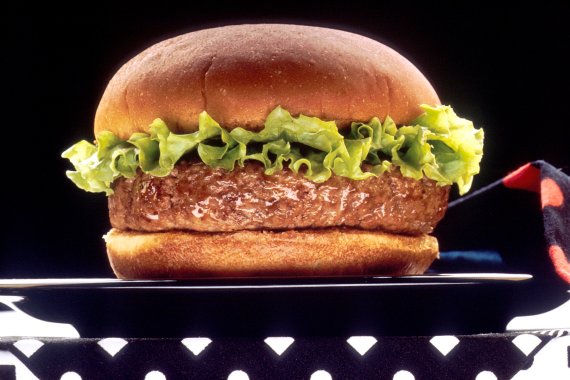A hamburger in a crusty roll with raw vegetables is more filling. (Credit)
Researchers at Human Nutrition demonstrated this by getting test subjects to eat hard and soft meals which were otherwise identical. They published their findings in the journal Plos ONE at the beginning of April. Per lunch, the test subjects turned out to eat an average of 63 grams, or about 16 percent, less from a relatively hard meal. In terms of energy, this means 93 fewer kilocalories. What is more, the participants did not compensate for their smaller lunches by eating more at dinnertime. The difference may not seem very big, says Dieuwerke Bolhuis, a postdoc at Human Nutrition, but if you can get people to change their behaviour on a systematic basis, you make a difference to levels of overeating. And this is very welcome in the battle against overweight, which affects more than 40 percent of the Dutch population. It is not so strange, really, seeing the way the supermarkets are full of easily digestible foods that are low on fibre and high on calories. Lead researcher Dieuwerke Bolhuis is therefore disappointed at the lack of interest in her results in the food industry. Giant food producer Nestle did fund her experiment, but it will not be followed up with further research. ‘In the long term there will be interest in satiety,’ thinks Bolhuis. ‘After all, people are more and more interested in health issues.’> They got harder food, took smaller mouthfuls and simply ate less — Dieuwerke Bolhuis
In the course of her experiment, Bolhuis got groups of 50 students to lunch for two days on as many hamburger rolls and as much rice salad as they wanted. At random, they were offered a ‘hard’ meal on one of the days, with crusty rolls and a salad of al dente rice and raw vegetables. On the other day, they were given soft rolls, risotto rice and cooked vegetables. On both evenings, the students returned for a normal meal. Meanwhile, the researchers kept track of precisely how much the participants ate, how many bites they took and how long the food stayed in their mouths. In her PhD thesis, Bolhuis had already shown that people eat less if they take smaller bites and keep the food in their mouths for longer. This happened under very artificial conditions, however – in which people could not see how much they were eating, for example. Now she showed that the same thing happens at a realistic lunch. ‘They got harder food, took smaller mouthfuls and simply ate less,’ says Bolhuis. ‘Exactly what we expected.’

